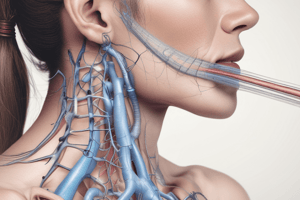Podcast
Questions and Answers
Which position should the examiner note the client is in when assessing the ability to support weight while breathing comfortably?
Which position should the examiner note the client is in when assessing the ability to support weight while breathing comfortably?
- Lying flat on the back
- Standing up straight
- Leaning backward on a chair
- Leaning forward with arms supporting weight (correct)
During palpation, what could tender or painful areas over the ribs, especially at the costal chondral junctions, indicate?
During palpation, what could tender or painful areas over the ribs, especially at the costal chondral junctions, indicate?
- Muscle tension
- Normal musculoskeletal function
- Fractured ribs (correct)
- Inflamed fibrous connective tissue
What might pain over the intercostal spaces indicate during palpation?
What might pain over the intercostal spaces indicate during palpation?
- Intercostal muscle growth
- Inflamed pleurae (correct)
- Normal lung function
- Rib dislocation
When examining for crepitus during palpation, what does palpable crepitus indicate?
When examining for crepitus during palpation, what does palpable crepitus indicate?
What does the absence of palpable crepitus suggest during examination?
What does the absence of palpable crepitus suggest during examination?
In which position should a client be ideally positioned for assessment in cases of acute and chronic airway obstruction or atelectasis?
In which position should a client be ideally positioned for assessment in cases of acute and chronic airway obstruction or atelectasis?
What is the purpose of palpating for tenderness and surface masses over the lung area?
What is the purpose of palpating for tenderness and surface masses over the lung area?
In which scenario can tenderness over thoracic muscles be commonly observed?
In which scenario can tenderness over thoracic muscles be commonly observed?
What condition might be suspected if hyperresonance is elicited during percussion of the lungs?
What condition might be suspected if hyperresonance is elicited during percussion of the lungs?
When palpating for crepitus, what abnormal sensation might be felt by the examiner?
When palpating for crepitus, what abnormal sensation might be felt by the examiner?
During auscultation, what are adventitious breath sounds?
During auscultation, what are adventitious breath sounds?
Why is it important to listen at each site for at least one complete respiratory cycle during auscultation?
Why is it important to listen at each site for at least one complete respiratory cycle during auscultation?
What is the purpose of assessing for fremitus during a physical examination?
What is the purpose of assessing for fremitus during a physical examination?
Why might a client need to speak louder during fremitus assessment?
Why might a client need to speak louder during fremitus assessment?
What condition might lead to an increase in fremitus?
What condition might lead to an increase in fremitus?
How should the examiner position the client when assessing for chest expansion?
How should the examiner position the client when assessing for chest expansion?
What does it indicate if the examiner's thumbs move asymmetrically when assessing chest expansion?
What does it indicate if the examiner's thumbs move asymmetrically when assessing chest expansion?
During palpation for crepitus, what might be a potential cause of crepitus under the skin?
During palpation for crepitus, what might be a potential cause of crepitus under the skin?




